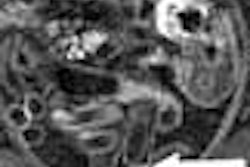BOSTON - VC fell short in the largest study to be reported at this year's International Symposium on Virtual Colonoscopy. The gastroenterologist-led trial at Duke University in Durham, NC, and 13 other centers yielded an average sensitivity of just 59% per patient for lesions 1 cm and larger at virtual colonoscopy.
Lead radiologist Dr. Erik Paulson, who presented the results at Thursday's opening session, was forthcoming about the limitations of the prospective comparison of virtual colonoscopy, conventional colonoscopy, and air-contrast barium enema (ACBE), in a study led by Dr. Don Rockey from Duke University Medical Center that aimed to evaluate alternatives to conventional colonoscopy.
Conceived in 1999 and finalized in 2000, the study did not benefit from the latest VC techniques, though it did use multidetector-row CT. More than half of the radiologists reading VC had performed fewer than 50 exams before the trial began, while the gastroenterologists had 14 years' average experience in conventional colonoscopy. And the radiologists had to work the interpretations into a busy clinical workday, Paulson said. The quality of the bowel prep and insufflation were not reported separately.
For its time the study design was reasonable, even careful, Paulson said. And if nothing else, virtual colonoscopy beat ACBE handily, despite the barium enema providers' 19 years of experience on average. Still, the preliminary results were so poor that the National Cancer Institute's Data and Safety Monitoring board recommended that recruitment be halted less than a quarter of the way through the intended 2,400-patient study -- by which time 614 patients had completed all three colon exams, Paulson said.
"It was a relatively high-risk patient population. They were fecal occult blood-positive, had hematochezia, iron-deficiency anemia, or family history (of colorectal polyps or cancer)," he said. "Patients initially underwent air-contrast barium enema, they then underwent a second (standard) bowel prep within a two-week period, and underwent same-day (VC) followed immediately by colonoscopy."
The researchers in each arm of the exam were completely blinded to the other test results. There was segmental unblinding of the VC and ACBE results during conventional colonoscopy, however, with results reported as the colonoscope was withdrawn from each segment. When findings were discrepant, the colonoscope was reinserted into the same segment for a second look, and the final results were rendered by consensus, Paulson said. Sensitivity was assessed by lesion location and size, and specificity was determined only by patient.
The adequacy of bowel prep (including insufflation) was evaluated on a five-point scale for each patient. In an effort to assess study preferences, participants were asked to complete questionnaires about their impressions of the exams immediately after each procedure, and again three days after each procedure. About half the patients were insufflated with room air, with the other half receiving CO2. There was no stool tagging, IV contrast, or antispasmodic agents.
CT was performed on four-slice scanners, using 2.5-mm collimation, 7.5-mm rotation, and 1-mm reconstruction intervals, and in both supine and prone positions. A few patients were imaged on 8- and 16-slice scanners as new machines were installed in the participating centers.
The VC studies were read immediately as they were performed, mostly on busy clinical days, Paulson said, and reported before conventional colonoscopy was performed, with sedation.
"There were seven (VC) readers who had read more than 50 cases at the start of the trial; there were eight readers who had read less than 50 cases at the start of the trial," he said.
Among the 614 patients (mean age 57.4 years, 70% male, 30% female) who managed to complete all three studies, the researchers identified 76 lesions 10 mm or larger in 63, including 46 adenomas and nine cancers. There were 154 lesions of 6-9 mm in 116 patients, including 97 adenomas but no cancers, the rest being mainly hyperplastic polyps, Paulson said.
Per-patient sensitivity for all lesions 10 mm and larger was 48% for barium enema, 59% for virtual colonoscopy, and 98% for optical colonoscopy. Among lesions of 6-9 mm, sensitivity was 35% for ACBE, 51% for CT, and 100% for conventional colonoscopy.
"The difference between (conventional) colonoscopy and (VC) was statistically significant (p < 0.001%) to a high level, but importantly, the difference between the results for (VC) and barium enema were statistically significant for the 6-9-mm lesions, and almost achieved significance for the 1-cm (and larger) lesions," he said.
For adenomas and cancers 1 cm and larger, the sensitivity of ACBE, VC, and colonoscopy were 55%, 64%, and 98%, respectively. The virtual colonoscopy readers missed two cancers, including a 20-mm lesion.
Even when the studies were divided into those with good bowel prep and those with poor bowel prep, VC produced no significant difference in sensitivity for either lesions of 6-9 mm or 1.0-cm and larger lesions, Paulson said. Parsing the results in terms of reader experience made little difference, he said.
"If we run our numbers based on the relatively experienced readers versus the relatively inexperienced readers, there was no significant difference between the readers, and in fact it turned out the inexperienced group had a higher (though statistically insignificant) detection rate than the experienced readers," he said.
As for future studies, the patients said they would be likelier to repeat conventional colonoscopy than virtual colonoscopy, Paulson said, crediting the sedation administered before conventional colonoscopy for its relative popularity. ACBE was the test most patients would prefer to steer clear of in the future. The participants were also "least satisfied" with the barium enema exam.
"In summary, I think that using this sort of circa-2000 technique, colonoscopy was more sensitive than either barium enema or (VC)," Paulson said. VC was more sensitive at detecting lesions than air-contrast barium enema, which was also the most uncomfortable test, he said. Advances in technology are certain to have an important and positive impact on future VC results, he added.
As for why these VC results were so poor, Paulson hypothesized that it was the lack of stool tagging and dedicated 3D read, and also that the VC cases were read "on the fly, in the middle of a busy day."
"(VC) reader experience might be an issue, but I doubt that based on the data I showed you," he said. "All three tests are probably acceptable if detection of cancer is the goal, and I believe that the (ACBE) may not be justifiable in patients in whom the objective is to detect polyps."
Among the many questions and comments heard after the talk, Dr. David Burling from St. Mark's Hospital in London said that reader performance has been shown to improve well into the hundreds of cases. Moreover, his group was not the first to find that radiologist performance in VC interpretation often declines after the initial training on 40-50 cases, only to pick up again. The lack of reader experience was probably the most critical shortcoming of the trial, he said.
Another audience member insisted that the lack of a primary 3D read was the principal culprit in the lackluster results. However, there is little consensus on this point, as the superiority of the 3D primary read has not been demonstrated independently of other factors.
By Eric Barnes
AuntMinnie.com staff writer
November 1, 2004
Related Reading
Gastroenterology warning: Prepare for VC or regret it, October 6, 2004
VC faces off (again) against second-look colonoscopy, October 4, 2004
VC fares better as its own gold standard, September 8, 2004
What virtual colonoscopy misses might not matter, August 18, 2004
Copyright © 2004 AuntMinnie.com



















